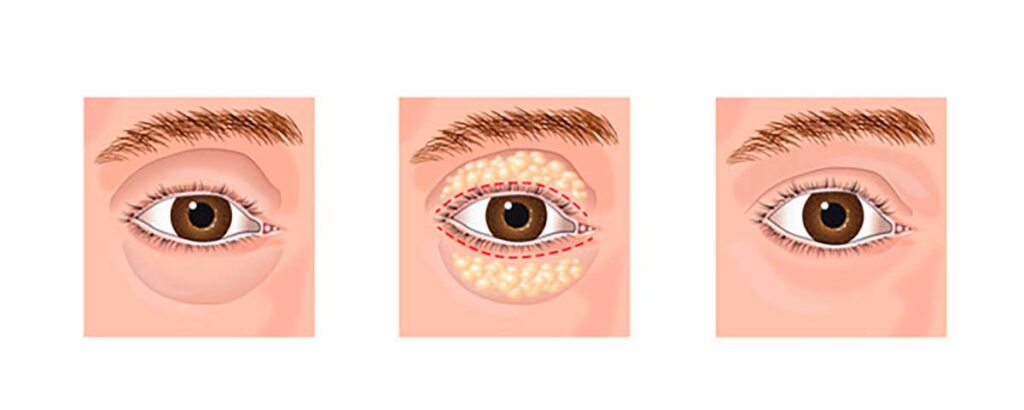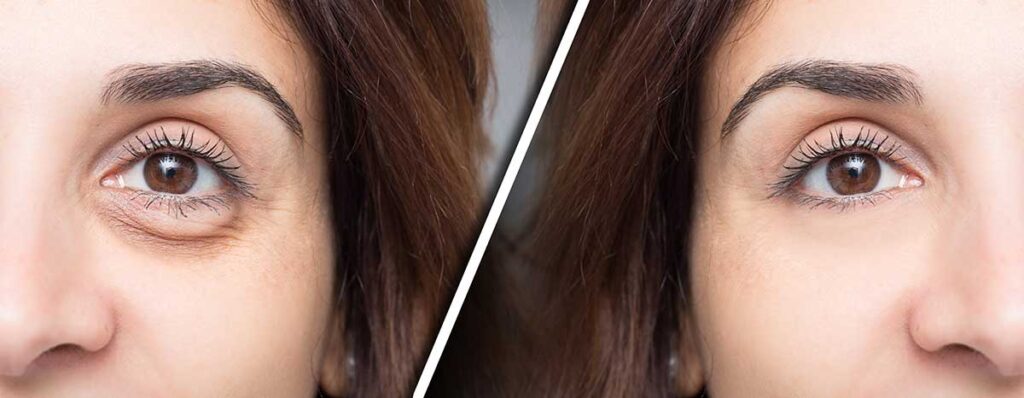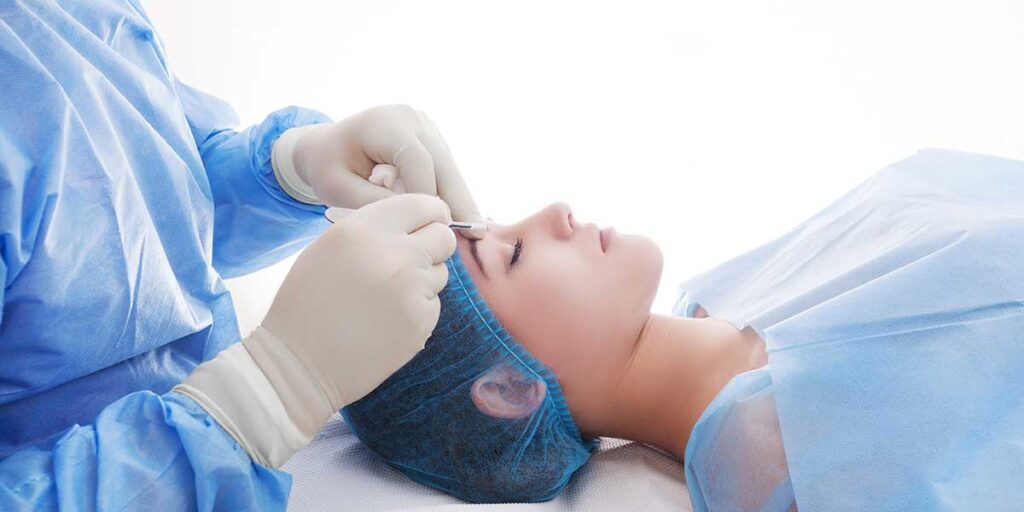Dr. Shazma Yousaf
Plot no : 40 Jhelum Rd, G 8/4 G-8, Islamabad, Pakistan
The skin around the eyes is particularly vulnerable to age-related changes. By the age of 35, most people notice that skin below the eyes becomes thinner and start to sag. Over the years, as the natural aging process continues, excess skin above the eyes and puffy bags below the eyes become more noticeable. These characteristics contribute to an aged and tired appearance, in addition to the excess skin on the upper eyelids which can cause vision problems. Eyelid surgery, technically referred to as blepharoplasty, is a surgical procedure that removes excess skin and reduces fat pockets, making the upper and lower eyelids smoother, contributing to a more youthful appearance. However, blepharoplasty does not eliminate black circles around the eyes and wrinkles commonly known as “crow’s feet”. Thus, it is possible to combine blepharoplasty with other procedures for optimal results – eyebrow lift, eye circles filling with hyaluronic acid or nano-fat or “crow’s feet” treatment with botulinum toxin. It can also be combined with brow lift to further improve the results of blephroplasty without any additional incision. Brow lift opens up the area around the eye and further contributes to the young and alert look.
Surgery time | 1 hour |
Anaesthesia | Local anaesthesia |
Type | Outpatient – the patient goes home on the same day |
Recovery Time | 2 weeks to go back to work |
Postoperative care | Total rest during the first 24 hours; use of cold compresses around the eyes; take medication according to medical advice; wear sunglasses and avoid strenuous activity. |

There are different blepharoplasty types and techniques. There is no standard method for all patients and each case is treated individually. Blepharoplasty is a “tailor-made” procedure which allows the plastic surgeon to improve both the appearance and eyes function.
Upper blepharoplasty: it involves removing skin, fat, and upper eyelid muscle that cause the eyes to become saggy and heavy. The scar is hidden in the natural fold of the upper eyelid. Also known as upper eyelid surgery, blepharoplasty will provide a more alert and youthful look.
Lower blepharoplasty: it involves removing fat bags, excess skin and muscle that contribute to the appearance of puffy eyes. A lower blepharoplasty involves a small incision along the eyelash line on the lower eyelid or inside the eyelid if there is no excess skin to be removed.
Note: The natural aging process can lead to separation or stitching of the muscle that lifts the eyelid, causing the eyelid to descend and cover part of the cornea. This condition is called eyelid ptosis and requires a different and specific approach. Your plastic surgeon will evaluate your case during the blepharoplasty consultation and will indicate the appropriate surgical treatment for your specific condition.

A blepharoplasty takes approximately 1 hour and it is performed in the following steps:
Before administrating local anaesthesia, the patient’s eyelids are marked. Standardized photographs are taken before and after marking.
Local anaesthesia is administrated in the area all around the eyes.
Skin is disinfected and blue wraps are placed to protect the eye area from external environment.
According to the type of blepharoplasty, incisions are designed so the resultant scars blend with the natural creases of the eyelid region.
According to the blepharoplasty technique, excess skin and fat are removed and muscles can be tightened.
Eyelid incisions typically are closed with sutures which are removed after 5/7 days.
Final results are checked before taking the patient to the recovery room. Results will appear gradually as swelling and bruising subside. Final results are expected after at least 3 months.
Lower blepharoplasty: if there are only fat pockets without excess skin, a transconjunctival blepharoplasty can be performed, in which a small incision is made in the inner part of the eyelid to extract the fat – the scar will not be visible at all. If there is excess skin to me removed, the scar will be in the lower eyelash line – it will fade away with time and become unnoticeable.
Upper blepharoplasty: When removing upper eyelid skin, the scar is hidden along the existing natural fold so it will only be visible when you close your eyes. It is a very fine line that will fade away with time and become unnoticeable.

Like in any other surgery, blepharoplasty also involves preparation. It is important to get ready and follow medical recommendations. The initial step to undergo an eyelid surgery is the first consultation with the plastic surgeon where the following will be evaluated:
Medical history: it is important to inform your plastic surgeon about any medical condition related to your eyes or other important issues such as medication you take, allergies, etc.
Expectations: you should share with your plastic surgeon your goals and expectations regarding the surgery. The plastic surgeon will be able to confirm if you are a good candidate for blepharoplasty and the appropriate techniques to achieve the desired results. It is important to be aware that surgery is not an exact science and the result depends on genetics and initial eyelids´ characteristics.
Here are some tips to better prepare for surgery:
After a blepharoplasty, you will remain in the recovery room for a few hours until you are able to go home – it is an outpatient surgery so you can return home on the same day. Blepharoplasty recovery is not particularly painful, but you may experience the following symptoms:
As with any other surgery, full recovery from a blepharoplasty takes time. It is important to know what to expect and follow medical instructions for a quicker and more comfortable recovery. Here are some recommendations for a good recovery:

Blepharoplasty results are long-lasting. In most cases, the removal of fat and excess skin is performed once is a lifetime. However, surgery does not stop the natural ageing process. As we age, eyebrow muscle strength diminishes which may lead to eyebrow descendance, forcing the eyelid to descend as well. In these cases, an eyebrow lift may be required, and not a second blepharoplasty. Maintaining a close relationship with your plastic surgeon is of utmost importance. Attend your follow-up appointments and get in touch whenever you have questions or concerns about your surgery results.
As with any other surgery, there are risks and complications associated with blepharoplasty but, fortunately, they rarely happen. Thousands of blepharoplasties are performed annually with a very low complication rate and with a very high satisfaction level. Here are some possible blepharoplasty complications:
To minimize the risk of complications, you must follow your plastic surgeon’s recommendations before and after the surgery. During your consultation, all the eyelid surgery potential risks and complications will be discussed in detail and you will be able to ask all your questions.
Dr Shazma is a qualified and experienced plastic surgeon from Islamabad with over 10 years of experience in performing eyelid surgeries – aesthetic and functional approach. Blepharoplasty requires knowledge of facial anatomy and a keen eye for cosmetic details, but also the necessary skills to adapt techniques to each patient’s goals and genetic characteristics. A good result is a result that looks natural for patient´s gender, age, ethnicity and facial features.
Each patient is different and experience different recovery periods. Blepharoplasty complete recovery ranges from one to four weeks but most swelling and bruising subsides after 10 days and patients are ready to go back to work after two weeks.
Yes, you can. It is very common to have peelings or laser resurfacing around the eyes to smooth out surface wrinkles.
Eyelid surgery does not fix sagging eyebrows. Sagging or hooded eyebrows are fixed by a brow lift which can be performed with a blepharoplasty in the same procedure.
Yes, you can. You can combine both procedures or have them done separately. Most patients that undergo a facelift procedure also perform a blepharoplasty.
Once the swelling subsides you can start using your contact lenses again usually after 2 to 4 weeks. However, you must always ask your plastic surgeon before start using them. Until then, use your glasses.
Blepharoplasty results are long lasting, but no surgery stops the natural aging process. Over time, skin elasticity and facial muscles continue to change. The brow can drop and cause excess skin to reappear in the upper eyelid, but this does not necessarily mean you will need a second blepharoplasty. You may need a brow lift at that time.
Blepharoplasty has been a very successful procedure in patients who have followed pre and post-surgery medical advice and have realistic expectations about the surgery´s outcomes.
Saggy skin and lower eyelid bags usually come with age. The right age to perform blepharoplasty is when changes in your eyelid start interfering with your daily life (functional reasons) or with your appearance (cosmetic reasons). In general terms, most blepharoplasty patients are at least 40-year-old, but this is not a rule. Many eyelid surgeries have been performed to patients on their twenties or thirties to treat droopy upper eyelids present at birth. If you feel you are a good candidate no matter what your age is, you should schedule an appointment with a plastic surgeon to evaluate your case.
Plot no : 40 Jhelum Rd, G 8/4 G-8, Islamabad, Pakistan
© Dr Shazma Yousuf . All Rights Reserved.
Terms & Conditions Privacy Policy